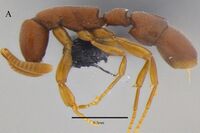Probolomyrmex lamellatus
| Probolomyrmex lamellatus | |
|---|---|

| |
| Scientific classification | |
| Kingdom: | Animalia |
| Phylum: | Arthropoda |
| Class: | Insecta |
| Order: | Hymenoptera |
| Family: | Formicidae |
| Subfamily: | Proceratiinae |
| Tribe: | Probolomyrmecini |
| Genus: | Probolomyrmex |
| Species: | P. lamellatus |
| Binomial name | |
| Probolomyrmex lamellatus Oliveira & Feitosa, 2019 | |
The single known specimen of this species came from a leaf-litter sample collected in mature lowland Amazon forest.
Identification
Oliveira & Feitosa (2019) - Propodeum and petiole entirely emarginated posteriorly by a conspicuous lamella, without teeth. Postero-ventral lobe of petiole short and subquadrate. Subpetiolar process weakly developed. Prora weekly developed and dorsal protuberance on the posterior region of the first gastral tergite weakly developed.
Probolomyrmex lamellatus is similar to Probolomyrmex cegua, but the head is comparatively longer, the propodeum and petiole are unarmed and completely emarginated by a dark lamella, and the postero-ventral lobe of petiole is subquadrate.
Keys including this Species
Distribution
Distribution based on Regional Taxon Lists
Neotropical Region: Brazil (type locality).
Distribution based on AntMaps
Distribution based on AntWeb specimens
Check data from AntWeb
Countries Occupied
| Number of countries occupied by this species based on AntWiki Regional Taxon Lists. In general, fewer countries occupied indicates a narrower range, while more countries indicates a more widespread species. |

|
Estimated Abundance
| Relative abundance based on number of AntMaps records per species (this species within the purple bar). Fewer records (to the left) indicates a less abundant/encountered species while more records (to the right) indicates more abundant/encountered species. |

|
Biology
Castes
Worker
Nomenclature
The following information is derived from Barry Bolton's Online Catalogue of the Ants of the World.
- lamellatus. Pobolomyrmex lamellatus Oliveira & Feitosa, 2019: 86, figs. 24-25 (w.) BRAZIL (Pará).
- Type-material: holotype worker.
- Type-locality: Brazil: Pará, Terra Santa, FLONA, Saracá-Taquera, Base Patauá, 9°51’27.23’’S, 56°27’48.4’’W, 70 m., 25-29.viii.2016 (R.M. Feitosa, E.Z. Alboquerque & R. Silva).
- Type-depository: DZUP.
- Distribution: Brazil.
Unless otherwise noted the text for the remainder of this section is reported from the publication that includes the original description.
Description
Worker
(n=1) HL 0.50; HW 0.30; SL 0.30; WL 0.59; PL 0.30; PW 0.24; PH 0.20; TL 2.11; CI 59.3; SI 59.3; PI 78.5.
Frontoclypeal shelflike projection micropunctate; mandibles foveated; external surface of mandibular basal margin large and imbricated. Antennal funiculi with pits; tip of apical segment of antennae bearing different sized pits. Mesopleuron foveate and micropunctate; metapleuron alveolate and foveated; lateral faces of propodeum foveated and micropunctate; alveoli denser just above metapleural gland orifice; opening of metapleural gland large, with smooth anterior region, surrounded by rows of hairs. Petiolar node and postero-ventral lobe of petiole with incomplete foveae and micropunctures; latero-ventral region of petiole and subpetiolar process alveolate. Posterior region of second gastral tergite with transversal rows of deep rounded pits.
Space between mesosomal foveae covered by dense pubescence. Head 1.8 times longer than wide. Hypostomal margin curved. Antennal scapes extend to head midlength, distance from scape apex to of head more than two times pedicel length (SI 59.3). Propodeum and petiole entirely emarginated posteriorly by a dark lamella, without teeth; Petiole 1.5 times longer than high (PI 78.5) posterior face short, straight, and smooth; postero-ventral lobe short and subquadrate; subpetiolar process weakly developed. First gastral segment with weakly developed prora and dorsal protuberance on posterior region of tergite weakly developed.
Type Material
- Holotype: BRAZIL: Pará: Terra Santa, FLONA, Saracá-Taquera, Base Patauá, 1°51’27.23”S 56°27’48.4”W, 70m, 25–29.viii.2016, R.M. Feitosa, E.Z. Albuquerque, R. Silva col, Winkler (worker ) [DZUP, unique specimen identifier DZUP 549767].
Etymology
The epithet refers to the posterior lamella of the propodeum and petiole, an exclusive characteristic of this species.
References
- Oliveira, A.M., Feitosa, R.M. 2019. Taxonomic revision of the genus Probolomyrmex Mayr, 1901 (Hymenoptera: Formicidae: Proceratiinae) for the Neotropical Region. Zootaxa 4614 (1): 61–94 (doi:10.11646/zootaxa.4614.1.3).
References based on Global Ant Biodiversity Informatics
- Oliveira A. M., and R. M. Feitosa. 2019. Taxonomic revision of the genus Probolomyrmex Mayr, 1901 (Hymenoptera: Formicidae: Proceratiinae) for the Neotropical Region. Zootaxa 4614: 61–94.


